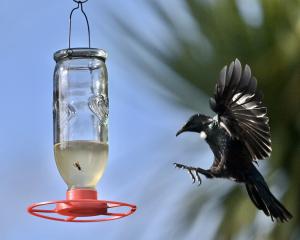‘‘Don’t let the house get in the way of the view.’’ That plea from the owners drove the design of this luxurious holiday home. Kim Dungey reports.
It's hard to believe that when the owners of this Wanaka house first met their architect on site, they could hardly see the lake due to dense vegetation.
The kanuka trees at the top of the section were 3m tall and it was not until they had climbed on to the roof of the architect's Subaru that they saw what the outlook might be when they were cleared.
From then on, the owners' brief evolved from two repeated phrases: ``Don't let the house get in the way of the view. It's all about the view''.

The 600sq m, five-bedroom holiday home and one-bedroom cottage were designed not only with the Perth-based owners in mind, but also their guests.
The main house includes a 177sq m living area with a 4.8m-vaulted ceiling and a schist-clad fireplace. There is also a semi-enclosed outdoor room, both areas opening to wide patios and a pool that is heated in summer.
The home is known as The Dacha, which is Russian for a country house, typically used as a second or holiday home, Lewis says.
``The wife is from New Zealand and the husband is Australian but they've lived and worked all over the world and have a strong connection to the many years they spent living, working and raising their girls in Russia.''
Located in Mount Gold Pl in the Penrith Park subdivision, the elevated, north-facing site has outstanding views of Lake Wanaka, Treble Cone skifield and the surrounding mountains. But the terrain was a challenge.
Being down a leg-in driveway, the site had no parking on the street so the small, flat area at the top of the property had to be used as a service and parking area.

A long stacked stone wall inside and out divides the service and entry side of the house, that faces the street, from the private, glazed side of the house that faces the lake.
The car and boat garages were split into two to reduce their visual impact and divided by a covered entrance large enough for vehicles to pass through.
The guest wing, with its own lounge, is at the opposite end of the house to the master suite, study and open-plan living/kitchen/dining area.
Lewis says the aim was to capture lake views from every room, using lots of glass, cantilevers and large spans: the roof over the 1.8m wide veranda, for example, has no posts to obstruct the view.
``Surprisingly, building a house that looks simple in shape, without a lot of posts and structure in the way, was actually very challenging.''
The outdoor room, with its own fireplace, can be used year-round with stacking glass doors providing shelter from the wind when needed.
Two of the guest rooms have en suites and walk-in wardrobes while the other two are bunk rooms with Japanese-style sleeping platforms. The mattresses are on sliding tatami mats and can be arranged to provide either single or king beds.
The bathroom layout for the bunk rooms is also unconventional, with the rooms separated into shower room, vanity room and toilet to provide maximum flexibility.

The house is clad in stone, glass and dark grey metal panelling.
The owners liked the idea of using natural cedar on the exterior but the ongoing maintenance was offputting. The solution was to use cedar on many of the ceilings and interior walls, giving a relaxing, holiday feel without the need to stain sun-beaten weatherboards.
Parts of the north-facing patio were built 3m above the existing ground level while stepped planter boxes allowed the pool fencing below to be screened from the house.
Further down the slope, a schist patio provides 360-degree views of the stunning surroundings and the owners added a retreat for their then-teenage daughters.
``Initially it was designed just to have a ping-pong table,'' Lewis says. ``There was no bathroom and it was more like a hut.''
During construction, however, the table tennis table was abandoned in favour of having a living area, bathroom and bed. The interior is lined in warm, rustic timber.
Making a large property with so much glass a truly passive home would have been almost impossible but harvesting energy from the site and using passive design principles were important, she says.

A ground-source heat pump runs the underfloor heating, bathroom radiators, the hot water cylinder and the boot drying rack.
To minimise heat loss, the floor slabs were built with double thickness. Insulation is sandwiched between the structural slab and the topping slab to eliminate thermal bridging through foundation walls.
Steel posts were exposed and brought to the warm interior part of the house, rather than having them positioned in walls to become cold bridges.
Aluminium joinery had low emission glazing and thermally broken frames.
An airtightness membrane was attached to the underside of the roof framing, with all services running below this layer. There is also a heat recovery ventilation system and provision for photovoltaic panels on the roof.
In total, the house, verandas, pool and cottage cover 1000sq m but the landscaping and dark metal cladding help the buildings blend into the surroundings.
Wanaka-based Lewis says the owner visited the site every four months during the two-year construction period and Skype meetings - one of which lasted five hours - ensured there were no surprises in between.
Shade and sunlight simulations were emailed to him in time-lapse format, allowing him to see the amount of light and sun planned for each room.
``He was also able to navigate through a 3-D model that he was able to access at his end so while we were on our Skype sessions, he'd be walking through the model and so would I.''
The home was a winner at the recent southern architecture awards, where Lewis was praised for her thoughtful handling of scale, attention to detail and careful selection of materials.
The owners, who rent the house out when they are not there, describe it as a place of peace and tranquillity: ``Our children have now left home, but The Dacha is our special place where we come together to remember, enjoy and reminisce.''




















